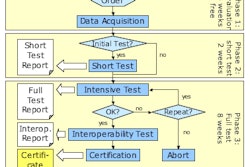In a sweeping bid to cut Medicare fraud, the U.S. Centers for Medicare and Medicaid Services (CMS) has issued new rules scheduled to go into effect February 26 that raise the bar for sites applying to be designated as an independent diagnostic testing facility (IDTF). The new compliance standards, issued late last month as a change request (5449), could dramatically change how IDTFs conduct their operations.
If implemented as scheduled, the new standards could make it much more difficult for freestanding outpatient imaging facilities seeking IDTF status to open.
These entities have come under scrutiny at CMS as Medicare costs skyrocket for diagnostic testing services. The agency served notice that IDTFs were on its radar last August in the 2007 proposal for the Medicare Physician Fee Schedule.
"In recent years, CMS and its contractors have determined that a number of IDTFs in California and other states are perpetrating schemes to defraud the Medicare program," CMS wrote. "The number of IDTFs billing Medicare in California alone increased more than 400% from 2000 to 2005. The increased use of IDTF services has not lowered the use of diagnostic testing within other settings."
CMS defines an IDTF as a supplier of diagnostic tests that is independent of a hospital or physician office and is administered in a fixed location, a mobile service, or a nonphysician practitioner. To qualify for Medicare coverage, IDTFs must comply with specific rules; for freestanding outpatient imaging centers, these are generally more restrictive than those required for facilities owned by radiologist physician group practices.
However, a number of imaging centers that function as IDTFs may find themselves entangled in the net that CMS is weaving, according to W. Kenneth Davis Jr., a partner in the Chicago-based law firm of Katten Muchin Rosenman. "A significant percentage of freestanding outpatient imaging centers are going to be affected by these new regulations," he said.
Reading the fine print
Specifically, the CMS transmittal addresses the implementation of new compliance standards for IDTFs that are to be included in chapter 10, Medicare Provider Enrollment, of publication 100-08, the Medicare Program Integrity Manual.
The new standards will affect multiple components of IDTF operation. These include:
- Technologist credentialing and employment
- Enrollment applications and billing
- Location of service and equipment sharing
CMS is requiring that each nonphysician (whom the agency calls a technician) who performs IDTF diagnostic tests must meet the standards of a state license or state certification at the time of the IDTF's enrollment. The IDTF must list the tests that each technician will perform on its application.
In addition, a copy of their license or certificate must be furnished at the time of an IDTF application. CMS will not accept certifications generated by an IDTF.
"There is no CMS-recognized national credentialing body for IDTF technicians," the agency wrote. "As such, the carrier shall not accept credentialing documentation from the IDTF as evidence per se that the technician is qualified to perform the listed test(s)."
For radiologic or nuclear medicine technologists working part-time, as independent contractors, or as representatives of a healthcare agency, the new compliance standards may prohibit their employment by an IDTF.
"If a specific license/certificate is required for nonphysician personnel, a supplier cannot contract with an individual or other entity to provide these licensed services," CMS wrote. "The owner of the supplier, or full-time W-2 employee, must have this license."
In effect, unless CMS changes this language, an IDTF can use only full-time technologists to perform exams at its facilities, according to Tom Greeson, a partner at law firm Reed Smith of Falls Church, VA. A CMS representative he spoke with yesterday indicated the agency is "relooking" at this provision.
Location of service and equipment sharing
The new CMS policy seems to attack a perceived problem in radiology, the growth of leasing deals, in which imaging facilities lease blocks of time on equipment to referring physicians. Two simple declarative sentences and one parenthetical element contained in the body of the CMS proposal are sure to raise the anxiety level of many facilities operating as IDTFs, as well as keep healthcare attorneys busy for months to come.
Each IDTF must certify on its enrollment application that it meets a variety of standards, including these two:
(An IDTF) may not share space with another active Medicare supplier. (Note: Physicians owning an IDTF and sharing space are exempt from this requirement.)
May not share equipment with any other IDTF or supplier.
"The threshold question under these standards is whether or not the facility is an IDTF," Davis said. "If it is an IDTF, what this means for them is unclear. Depending on how CMS defines the term 'share,' this will determine what this means."
"For example, when a physician leases a piece of equipment in a space they are usually exclusively leasing and using that piece of equipment when they are conducting a procedure with it, no one else can use it at that time," Davis said. "I would argue that that's not sharing. But, CMS may say that is, in effect, sharing."
Greeson observed that the equipment-sharing prohibitions will not only affect IDTFs.
"Physicians who have an office in the same building as an IDTF is located; have met all the Stark in-office ancillary services exemptions; and have leased blocks of time in a manner that is fully compliant with the safe harbors for space, equipment, and personnel -- what CMS has indicated is that these part-time lease arrangements will no longer be permitted by the IDTF," he said.
"This is not a restriction that is being imposed by CMS on any other entity," Greeson said. "A hospital can have a lease arrangement, a radiology practice can have a lease arrangement, a physician practice can have a lease arrangement with another physician practice -- this (policy change) is only targeted at IDTFs."
No matter how one parses the language, lease deals for multispecialty practices commonly include shared space for the providers, such as reception areas and lunch rooms, Davis noted.
"At its most extreme interpretation, this regulation may mean that leasing relationships, infrastructure relationships, and such cannot be engaged in by IDTFs," he said.
The exemption for a physician-owned IDTF is also troubling for Davis.
"Does it mean that if you had an IDTF that is partially owned by a physician, does or doesn't that mean the exemption applies to them?" he said. "For example, a common joint-venture model is an IDTF owned by a radiology group and a hospital; is that IDTF exempt from this requirement? I don't know."
Enrollment applications and billing
Facilities applying to the IDTF program may also find it takes longer to start receiving their first Medicare payments. Currently, an IDTF can apply for enrollment as a CMS provider, conduct business, and bill for services performed during the enrollment waiting period once its application is approved. This is going to change.
"The contractor (CMS) shall establish the effective billing date of applications received on or after the implementation date of this instruction as the date the application was approved by the contractor. In the latter scenario, this means that services rendered before the date the contractor approved the application will not be covered," CMS wrote.
After February 26, an IDTF will have to have its facility, equipment, and staff in place and operationally ready to satisfy the agency's site visit requirements -- and then wait for its enrollment application to be processed before it can bill for services. Simply opening the practice to private payors would be an attractive option; however, many private payors insist on a successful IDTF enrollment prior to establishing a contract with a facility, Greeson noted.
According to Greeson, 90- to 180-day waits for CMS to approve an IDTF's enrollment are not unheard of. A three- to six-month delay in doing business while paying overhead for facility, equipment, and staff is a high barrier to entry in the marketplace, Davis observed.
But, with the new compliance standards, this lead time for enrollment approval could become even longer.
CMS has now deemed it necessary for every IDTF location, including mobile coaches, to submit its own enrollment application.
"The IDTFs must separately enroll each of their practice locations (with the exception of locations that are used solely as warehouses or repair facilities)," CMS wrote. "This means that each enrolling IDTF can only have one practice location on its CMS-855B enrollment application; thus, if an IDTF is adding a practice location to its existing enrollment, it must submit a new, complete CMS-855B application for that location and have that location undergo a separate site visit. Also, each of the IDTF's mobile units must enroll separately."
"A fair concern is that with the new, more robust IDTF application process that is set forth here, you may see the application timeframe get even longer," Davis said.
In case a multilocation or multistate IDTF does not want to take the new regulations seriously, the agency put some teeth into the transmittal.
"Failure to comply with any of these requirements at any practice location represent the supplier's noncompliance with 42 CFR § 410.33 as a whole, and will result in the revocation of its Medicare billing privileges," CMS wrote.
Get a good lawyer
The implications of new CMS policy could be undoubtedly severe for IDTFs; however, as the attorneys note above, there are a number of questions as to what specific interpretations of these new regulations CMS expects IDTFs to follow. They both recommended that IDTF practices should consult with a healthcare attorney to determine the best way to move forward in light of the complexity of the situation.
"Until we know ultimately what CMS intends to do, and what their position is as to what the meaning is for some of these provisions, I think all we can do is be aware and, to the extent possible, comply with the regulations," Greeson said.
By Jonathan S. Batchelor
AuntMinnie.com staff writer
February 13, 2007
Related Reading
DRA's arrival forces imaging centers to adapt, February 1, 2007
DRA threatens to throttle PET, October 13, 2006
Study finds 87% of DRA reimbursement below procedure cost, September 19, 2006
Reassignment rule proposal offers mixed bag for imaging, August 18, 2006
DRA 2005 in practice: Where the rubber meets the road, April 27, 2006
Copyright © 2007 AuntMinnie.com



















